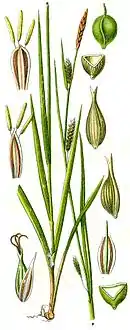Carex laevigata
Carex laevigata, the smooth-stalked sedge,[1] is a species of sedge. It lives in moist, shady environment in the lowlands of Western and Central Europe, particularly in alder–ash woodland.[2] It is distinguished from similar species, such as C. binervis and C. distans by the presence of tiny red dots on the utricles.[2] Carex laevigata was first described by James Edward Smith in 1800, in a paper in the journal Transactions of the Linnean Society of London.[3]
| Carex laevigata | |
|---|---|
 | |
| Scientific classification | |
| Kingdom: | |
| (unranked): | |
| (unranked): | Monocots |
| Order: | |
| Family: | |
| Genus: | |
| Subgenus: | |
| Section: | |
| Species: | C. laevigata |
| Binomial name | |
| Carex laevigata | |
References
- "BSBI List 2007". Botanical Society of Britain and Ireland. Archived from the original (xls) on 2015-01-25. Retrieved 2014-10-17.
- A. C. Jermy; D. A. Simpson; M. J. Y. Foley; M. S. Porter (2007). "Carex laevigata Sm.". Sedges of the British Isles. BSBI Handbook No. 1 (3rd ed.). Botanical Society of the British Isles. pp. 356–357. ISBN 978-0-901158-35-2.
- James Edward Smith (1800). "Descriptions of five new British species of Carex". Transactions of the Linnean Society of London. 5 (19): 264–273. doi:10.1111/j.1096-3642.1800.tb00600.x.
This article is issued from Wikipedia. The text is licensed under Creative Commons - Attribution - Sharealike. Additional terms may apply for the media files.